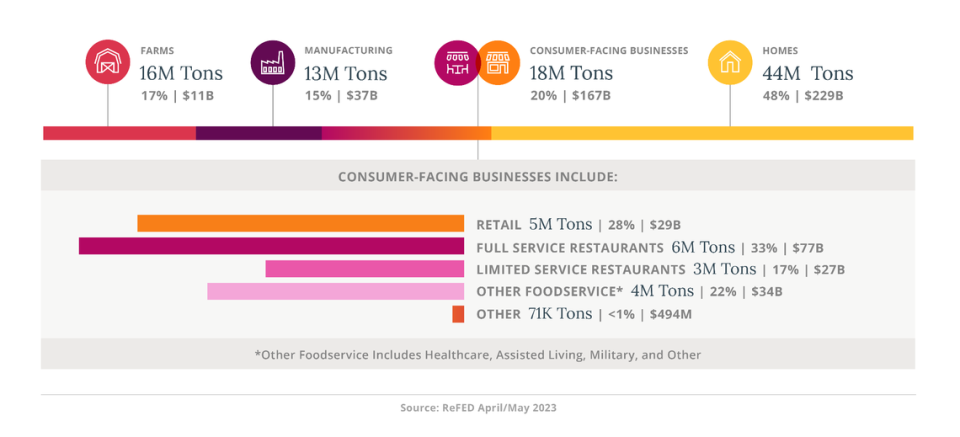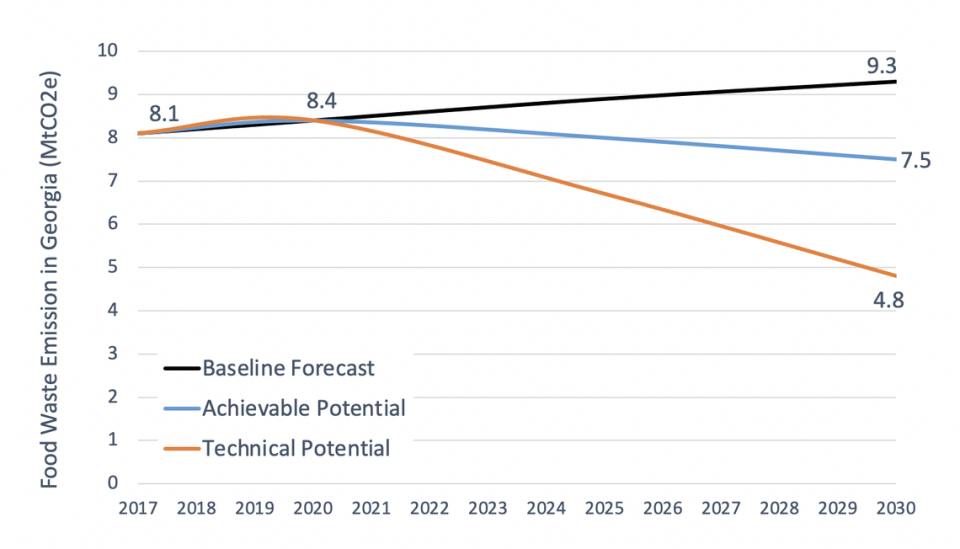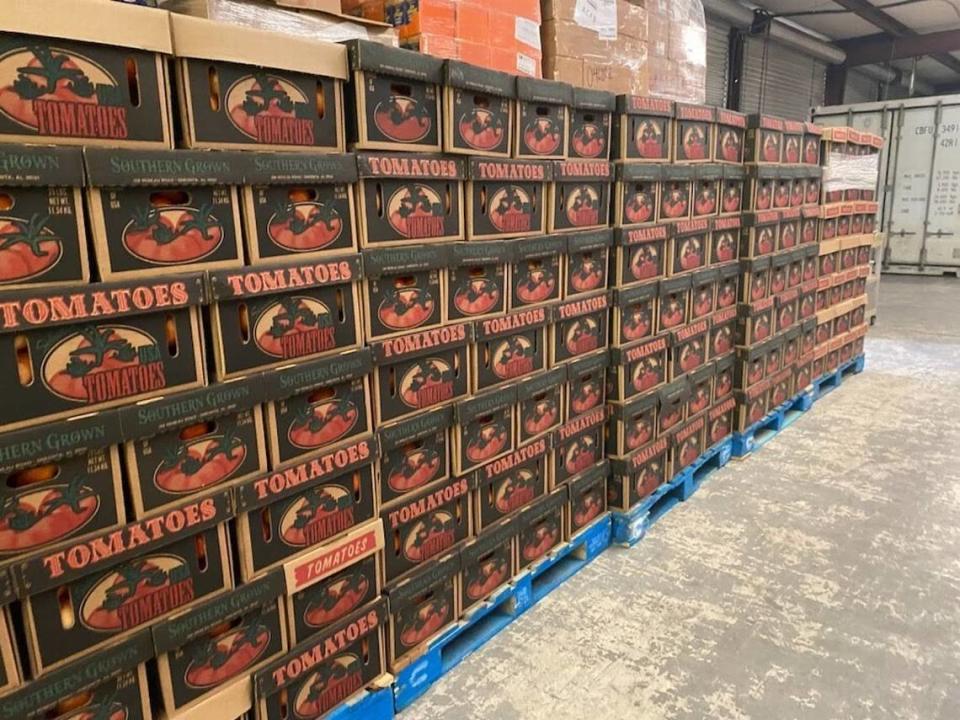Reducing household food waste is the best climate action Georgians can take. Here’s why.
In Southwest Georgia, 35,000 pounds of tomatoes were minutes from going to a landfill. An exceptionally great yield left a farmer in rural Georgia scrambling to sell the overflow.
In the nick of time, Retaaza, a food rescue group, purchased the entire truck of tomatoes and donated it to a food bank in Austell, Georgia.
Every year 4 billion (yes billion) pounds of food end up in Georgia’s landfills, mostly from households, according to Georgia EPD.
“When you waste food it ends up in landfill and produces methane [a potent greenhouse gas]–unless it is composted or incinerated,” James Gerber, a senior scientist from Project Drawdown, the national climate change solution think tank said. “The agriculture system that produces what we eat is a huge contributor to human-caused climate change. One-quarter of global emissions is just the production of food.”
The food wasted in Georgia equates to 8.3 megatonnes of CO2. That is nearly the same amount of emissions that come from the state’s highest Coal Power Plant, Plant Bowen, which emits 7.93 megatonnes a year.
Fighting food insecurity, waste, and emissions
The past year food insecure households, who lack reliable access to quality nutritious food, have increased by 31%, which is the largest jump since 2008, according to the USDA’s latest food security report.
Columbus’ Feeding the Valley Food Bank acquired 15 million pounds of food this past year, providing meals to nearly 80,000 people.
More than half of the produce that Feeding the Valley provides is rescued from grocery stores and distribution centers.
“Walmart would put it in their landfills if they didn’t send it to us,” Margalena Remington, Food Sourcing Manager at Feeding the Valley said. If they have excess in something, or not aesthetically pleasing it is sent to Feeding the Valley.
Currently, Feeding the Valley is constructing its 24,000-square-foot space, doubling their dry storage space, and a 50% increase in their cold storage space. These numbers mean less food waste in the landfill and less greenhouse gas emissions.
“All of the funding has been achieved,” Jennifer Shawa, Director of Development at Feeding the Valley told the L-E. “We will have a climate-controlled volunteer center, and have a room dedicated to educating people about food insecurity.”
Combating hunger can combat climate change
Powering a home with solar panels, purchasing an EV, taking public transit, or updating insulation are powerful climate actions individuals can take. However, they can come at burdensome costs or cumbersome lifestyle changes. Lessening food waste is an attainable and accessible undertaking.
“From a climate mitigation perspective, [reducing waste] is something that you actually have a hundred percent control over for yourself”, Jeff Mullen an agricultural and applied economics professor at the University of Georgia said. “It’s something that you, personally, can do something about just with your own choices, and it will save you money.”
In early October, Project Drawdown released a list of the highest-impact climate actions to take at a household level. The number one action on their list? Reducing food waste.

Experts at ReFed, an organization dedicated to fighting food waste with data and analytics, break down the waste origins even further, highlighting the household level is the highest slice of the pie at 48%. Followed by restaurants and grocery stores at 20%, and farms at 17%.
The Atlanta-based start-up, Goodr, tackles the second-highest source of food waste: consumer-facing businesses.
“We’re the Uber for surplus food,” Grayson Stuart, Sustainability Coordinator with Goodr said.
Goodr is the “logistical arm” that takes prepared food from cafeterias, restaurants, event centers and redistributes it to those who need it through pop-up grocery stores.
Retaaza, also based in Atlanta, has rescued 428,000 lbs of food from farms since they began operations a few years ago. Retaaza donates to food banks, and hospitals, or sells the rescued food to corporations to have meals for employees, Kashi Sehgal, Retaaza CEO told the L-E.
“We are [farmers] just-in-time resource,” Sehgal said. The food that Goodr and Retaaza save from landfills equates to millions of poundsof greenhouse gasses diverted.

However, if Georgia reduces it’s food waste by 12%, that amount would reduce to 7.5 megatonnes of CO2 by 2030. Mullen calls this achievable, more of a realistic scenario. In an optimal, “everything goes right” or technical scenario, Georgia could reduce its emission to 4.5 megatonnes by 2030 by eliminating 50% of food waste.
How To Reduce Waste
Eating Seasonally: Sehgal insists consumers need to remember that food “is a resource, it’s life”. She also embraces the practice of eating what is in season. “Tomatoes are not always in season,” she said. “Watermelon is not always in season. But, you can get it at the grocery store literally any day you want. Eating seasonally would help people under how to eat locally [and reduce waste]”

Planning our meals is paramount to reducing waste.
“Better planning and food management behaviors are critical to reducing household food waste,” Brenna Ellison, agricultural & economics associate professor at Purdue University said in an email. “I always encourage people to be realistic meal planners rather than optimistic meal planners.”
If you are going to likely get takeout a few nights a week, plan accordingly. “Use a first-in, first-out inventory approach,” Ellison said. Use the older items first.
The Georgia EPD has a list of tips to reduce food waste and help Georgia meet its climate emission reduction goals which mirror much of Ellison’s recommendations.
Reevaluate product dating: Don’t automatically throw away food because of the date provided on the product. “Sell by” tells the store how long to display the product. “Best by” is recommended for best flavor not a purchase or safety date. “Use-by” is the last date recommended for the peak quality, determined by the product manufacturer.
Prep foods right after shopping: Wash, dry, chop, dice, and slice produce in a clear storage container. For berries, wash before storing them in the refrigerator to prevent mold.

